The first public radio station in Australia opened in
Sydney on 23 November 1923 under the call
sign 2SB. Other stations in
Melbourne,
Brisbane,
Adelaide,
Perth and
Hobart followed. A licensing, scheme administered by the Postmaster-General's Department, was soon established allowing certain stations government funding, albeit with restrictions placed on their advertising content.
In 1924 the licencing system was changed. The Postmaster-General's Department collected all licence fees and broadcasters were funded as either A-Class or B-Class stations. A-Class stations received government funding and were able to take limited advertising, while B-Class stations received no government funding but could carry more advertising. By 1925 many of the A-Class stations were in financial difficulty.
A 1927 Royal Commission into wireless broadcasting recommended that radio licence fees be pooled to fund larger A-Class stations. The government established the National Broadcasting Service to take over the 12 A-Class licences as they came up for renewal from 1928. The original legislation permitted advertising, but this was removed from the Act before it came into effect. At the same time, the government created the Australian Broadcasting Company to supply programs to the new national broadcaster.
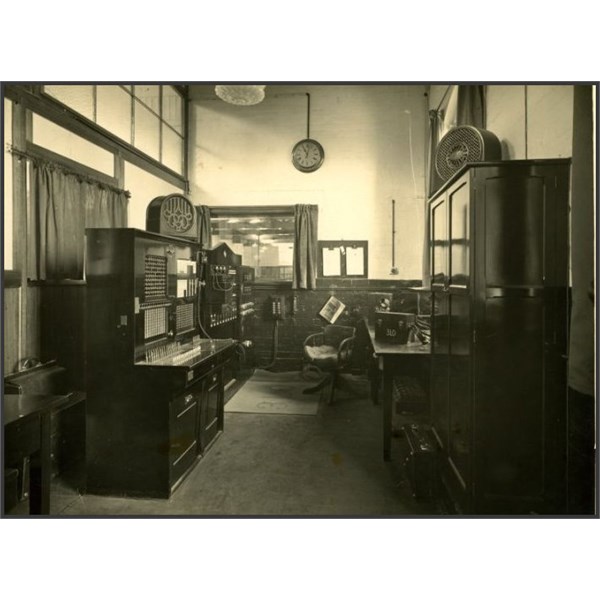
Control room at 3LO Studios, Melbourne, Victoria, 1928
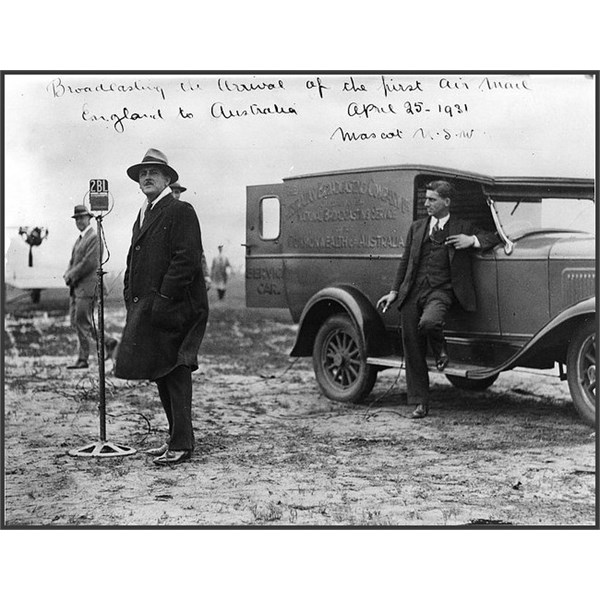
Broadcasting the Arrival of the first Air Mail from England to Australia April 25th 1031 at Mascot.
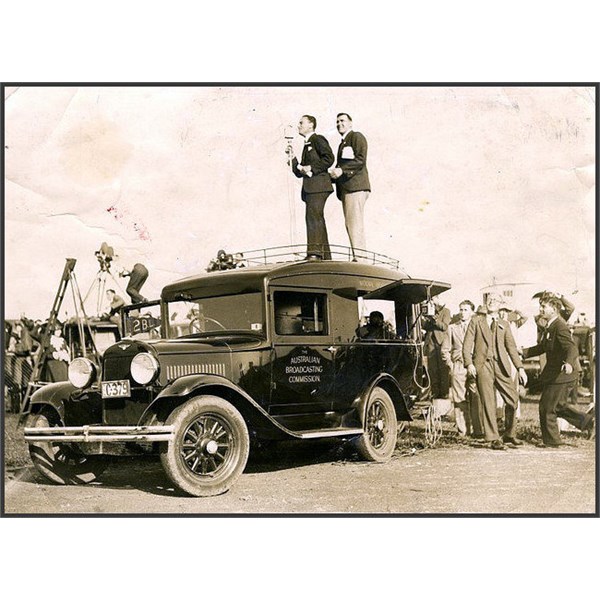
Outside Broadcast (OB) for Jean Batten's flight NZ to Australia
Initially the Postmaster-General's Department, which operated postal and telephone
services, was responsible for operating the National Broadcasting Service, although this arrangement did not have universal political support. As a result, the Australian Broadcasting Commission was established on 1 July 1932 to take over the Australian Broadcasting Company and run the National Broadcasting Service. The ABC was to be based on the BBC model, funded primarily from listener license fees with some direct government grants.
The Australian Broadcasting Commission's original twelve radio stations were,
2FC
Sydney , 2BL
Sydney, 3AR
Melbourne, 3LO
Melbourne, 4QG
Brisbane
5CL
Adelaide, 6WF
Perth , 7ZL
Hobart, 2NC
Newcastle, 2CO Corowa
4RK
Rockhampton , 5CK
Crystal Brook.
These formed the basis for the present-day ABC Local Radio and Radio National networks.
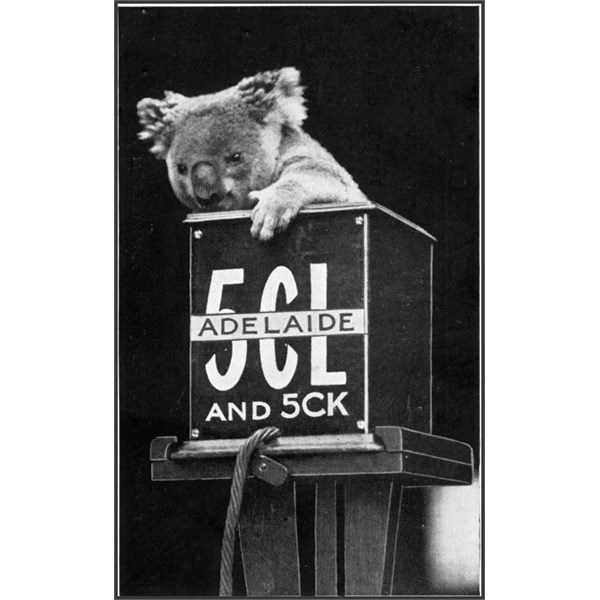
5CL Adelaide microphone with Koala
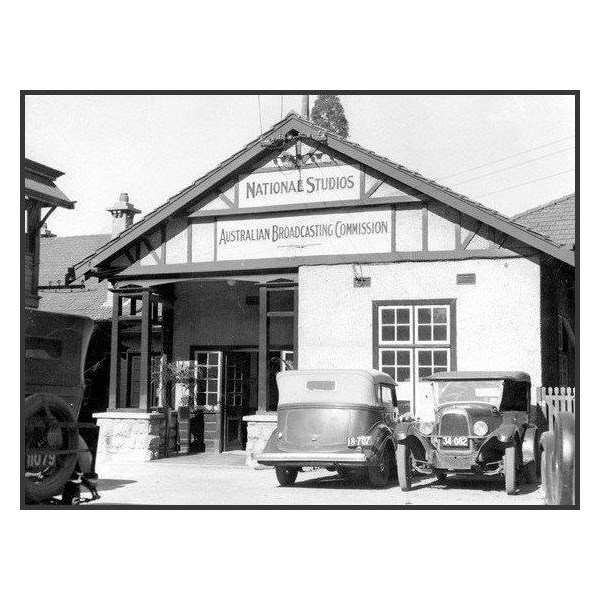
The ABC's Perth headquarters in 1937
At its conception, the Commission was headed by five commissioners appointed by
the Governor-General. From these five commissioners, one was appointed to the office of chairperson and another to the office of vice-chairperson. This board of directors then appointed a General Manager that did not have the office of commissioner. International broadcaster Radio Australia was incorporated into the Australian Broadcasting Commission in 1932.
The opening-day program included the first Children's Session with 'Bobby Bluegum', the first sports program, 'Racing Notes', with WA Ferry calling the Randwick races, 'British Wireless News', received by cable from London, weather, stock exchange and shipping news, the ABC Women's Association session (on 'commonsense housekeeping' and needlecraft), a talk on goldfish and their care, as
well as 'Morning Devotions' and music. Conductor Sir Bernard Heinze was appointed part-time musical adviser to the ABC in 1934, while in 1937, the network was further expanded with the purchase of
Brisbane's 4BC. Two years later, the Commission began publishing the ABC Weekly - a radio magazine promoting the ABC's local radio, and later television, programs.
Over the next four years the stations were reformed into a cohesive broadcasting organisation through regular program relays, coordinated by a centralised bureaucracy. The Australian broadcast radio spectrum at the time was made up of the ABC and the commercial sector.
During the broadcaster's first decades, programs generally consisted of music, news and current affairs, sport, drama, children's educational supplements and school broadcasts. Because recording technology was still relatively primitive, all ABC programs (including music) were broadcast live until 1935, when the first disc-based recorder was installed at the Commission's
Sydney studios. For this purpose, the ABC established broadcasting orchestras in each state, and in some centres employed choruses and dance bands.

Erecting radio mast for 4RK Rockhampton in 1931
Amongst the other early programs were the stations' famous 'synthetic' cricket broadcasts - when tests were played in England, commentators in the ABC's
Sydney studios used cables from London and sound effects to recreate the match in play. In addition, all 38 of Shakespeare's plays were performed live between 1936 and 1938.[1] Local drama was also produced, with a competition for plays and sketches from Australian authors held in 1934. Talks from prominent figures of the time such as King George V, Pope Pius XI, British Prime Minister Ramsay MacDonald, German Chancellor Adolf Hitler and H.G. Wells were also broadcast.
By 1933 regular program relays were in place between the ABC's stations in
Sydney,
Melbourne,
Brisbane,
Adelaide and
Perth - it was not until 1936 that
Hobart was connected with the mainland, through a cable under the Bass Strait. News bulletins, however, continued to be read in each state from local newspapers (by agreement with the Newspaper Proprietors Association). It was not until 1934 that the ABC hired its first journalist - the service continued to be expanded, with the appointment of a Federal News Editor in 1936, and in 1939 a
Canberra correspondent to cover national politics.
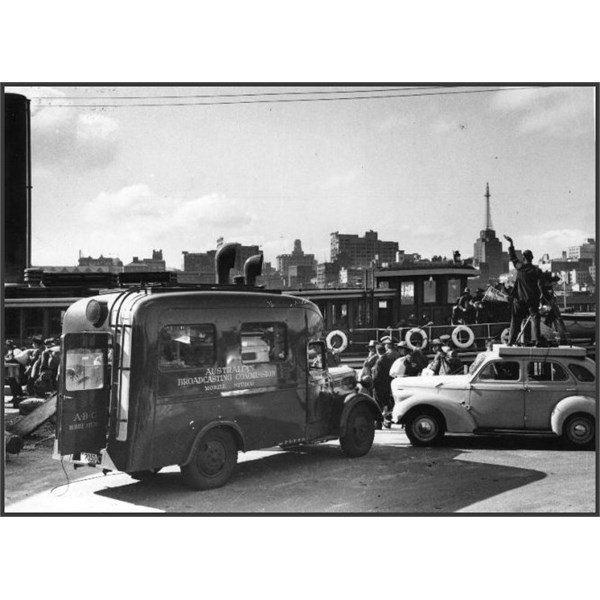
The ABC's first Mobile Unit covering the embarkation of troops from Darling Harbour 1939
During the Second World War, the ABC continued to recruit staff, including a greater proportion of women to replace men who had joined the armed forces. The organisation established reporting and recording facilities in a number of overseas locations, including the Middle East, Greece and around the Asia-Pacific region. An early challenge to its independence came in June, 1940 when wartime censorship was imposed, meaning that the Department of Information (headed by Sir Keith Murdoch) took control of the ABC's 7 p.m. nightly national news bulletin. This lasted until September, when control of the news was returned to the ABC after listeners expressed a preference for independent news presented by the Commission.
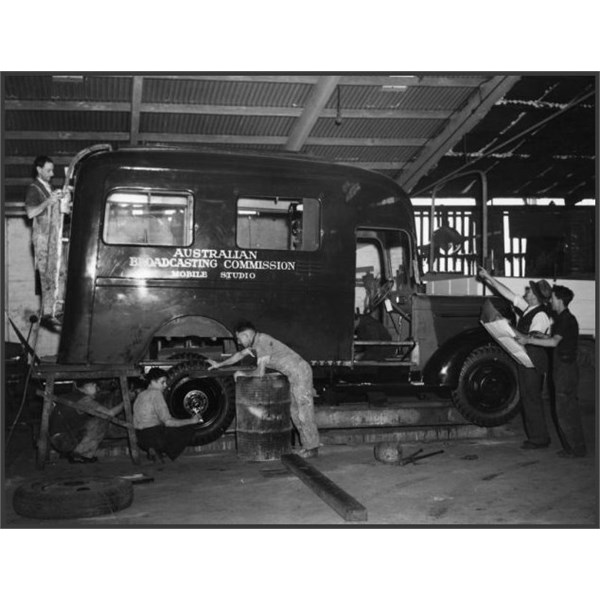
ABC mobile studio Van used with AIF in Middle East
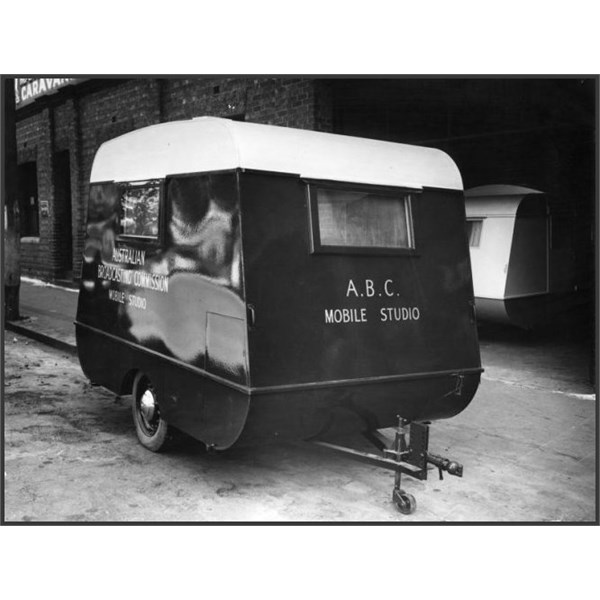
Caravan adapted as an ABC mobile studio to be used for concerts presented by the ABC at army camps and other locations
Note: The vehicle that went to the ME was modified by the Army to have 6 wheels.
During the war, the ABC's news bulletins attained a reputation for authority and independence, and from 1942 onwards,[citation needed] were broadcast three times daily through all national and most commercial transmitters. During and after the war, the ABC was given statutory powers that reinforced its independence from the government and enhanced its news-gathering role. From 1946, the ABC was required to broadcast selected parliamentary sessions live, despite the disruption this caused to regular programming.
On 7 January 1941 the ABC revived the Children's Session as a national program, including the "Argonauts Club", which was first broadcast in 1933-34 in
Melbourne. The Argonauts Club proved hugely popular with
young Australians - by 1950 there were over 50,000 members, with 10,000 new members joining each year through 1950s. The Club encouraged children's contributions of writing, music, poetry and art, and became one of the ABC's most popular programs, running six days a week for 28 years.
In 1942 The Australian Broadcasting Act was passed, giving the ABC the power to decide when, and in what circumstances, political speeches should be broadcast. Directions from the Minister about whether or not to broadcast any matter now had to be made in writing, and any exercise of the power had to be mentioned in the Commission's Annual Report.[8] It was used only once, in 1963. In the same year, "Kindergarten of the Air" began on ABC Radio in
Perth. It was later broadcast nationally and became one of the ABC's most popular programs.
Another Act passed in the same year required that one of the commissioners be a woman. In 1948, another was passed increasing the number of commissioners to seven and specifying that two must be public servants - one each from the Treasury departments and the Postmaster-General's department. Although the requirement for public servants was dropped in the Broadcasting and Television Act of 1956, the need for seven commissioners was retained - this allowed for each state and territory to be represented.
By the end of World War II, the ABC was a decadent, hollow institution. Its authority had been compromised by a poorly drafted charter and further undermined by timid management, poor governance and creeping wartime censorship. In April 1945, Richard Boyer refused to accept the post of chairman until Prime Minister Curtin issued a mandate of independence which Boyer drafted itself. The ABC under Boyer and general manager Charles Moses invested as best it could in the cultural capital of the nation, establishing viable symphony orchestras and seizing on the potential of television.... His neutrality was never seriously questioned.
In December, 1945 rural affairs program "The Country Hour" premiered. Legislation passed in 1946 requiring the ABC to broadcast Parliament when in session, the broadcasts were put onto the interstate network, however the Commission frequently commented on the disruption this caused to its programming in its annual reports. The ABC was also required to 'secure its news for broadcasting purposes within the Commonwealth by its own staff, and abroad through such overseas news agencies and other overseas sources as it desired' (along with its own foreign correspondents). The news department continued to expand, and was inaugurated on 1 June 1947.
Around the same time, Prime Minister Ben Chifley pledged that his government would aim to introduce television to the country as soon as possible. Changes to the ABC's funding structure took place in 1948 - amendments were made to the Broadcasting Act with the effect that the ABC would no longer receive its finances from licenses, but from a government appropriation.
Long-running regional affairs program The Country Hour began in December, 1945. The ABC's coverage of rural affairs was significantly enhanced by the deployment of journalists and 'extension officers' to major country areas. The increasing availability of landlines and teleprinters allowed the organisation to gather and broadcast news and other program material with much greater efficiency than in the previous two decades. By this time, as many as 13 national news bulletins were broadcast daily.
In 1953, the federal Television Act was passed, providing the initial regulatory framework for both the ABC and commercial television networks. Over the next three years, planning for the introduction of a national television service was put in place - land for studios and transmitters in
Sydney and
Melbourne was acquired, and overseas tutors were brought to Australia to assist with training.
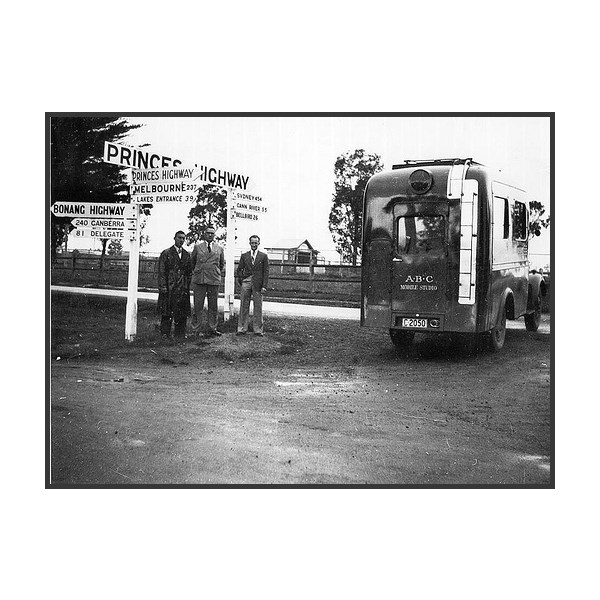
ABC Mobile Studio Van On Princes Highway
Although radio programs could be broadcast nationally by landline, television relay facilities were not put in place until the early 1960s. This meant that news bulletins had to be sent to each capital city by teleprinter, to be prepared and presented separately in each city, with filmed materials copied manually and sent to each state.
The ABC was one of the first television networks to embrace
the rock'n'roll revolution of the late 1950s, most notably with Six O'Clock
Rock, hosted by Johnny O'Keefe. During the 60s and early 70s the ABC continued to produce programs on popular music, including the pop show Hitscene,[citation needed] performance specials by groups such as
Tully and Max Merritt & The Meteors, as
well as the magazine-style program GTK,[citation needed] which premiered in 1969 and screened for 10 minutes, four nights per week at 6.30pm, immediately prior to Bellbird and the 7.00pm news bulletin.
Although it was long thought that most of this priceless material had been erased - much like the BBC, an "economy drive" undertaken in the late 1970s led to the erasure of large amounts of videotaped material, including most of the first two years of Countdown.[citation needed] However, extensive archival research within the ABC following the recent closure of the old Gore
Hill studios in
Sydney has revealed that, although some early videotape-only content was erased, much of the primary footage had (fortunately) been shot on film and most of this was retained.[citation needed] It is believed that approximately 80% of GTK has survived. In the early years of television, the ABC had been using Lissajous figures as fillers in-between programs. A staff competition was conducted in 1963 to create a new logo for use on television, stationery, publications, microphone badges and ABC vehicles. Graphic designer, Bill Kennard, who had been experimenting with telerecording of the Cathode Ray Oscillograph displays, submitted a design in 1965 which was part of the waveform of an oscilloscope. The letters A-B-C were added to the wavelength design and it was adopted as the ABC's official logo. Mr Kennard was paid twenty five pounds for his design.
In 1967, the weeknightly television current affairs program, This Day Tonight, and its counterpart on radio, PM, were introduced. The ABC also focused on producing radio and television talk programs that explored a wide range of national and international issues.[citation needed] Prominent among these was The Science Show, which began in 1975, hosted by Robyn Williams. In the same year radio program, Coming out ready or not (later known simply as The Coming Out Show), produced by the Australian Women's Broadcasting Cooperative, launched, dealing with women's issues.
The ABC also opened a number of new overseas news bureaux - new offices were opened in Jakarta and Kuala Lumpur in 1964, New Delhi and Tokyo in 1966, Washington in 1967, and Bangkok in 1972. Radio Australia also broadcast special news bulletins to Australian and New Zealand armed forces in Vietnam, with 20 correspondents covering the conflict between 1965 and 1972.
In 1975, colour television was introduced in Australia. Within a decade, the ABC had moved into satellite broadcasting, enhancing its ability to distribute content nationally. In the same year, the ABC introduced a 24-hour-a-day AM
rock station in
Sydney, 2JJ (Double Jay), which was eventually expanded into the national Triple J FM network.[13] A classical music network was established a year later on the FM band, broadcasting from
Adelaide. It was initially known as ABC-FM - referring both to its 'fine music' programming and radio frequency.
The first ABC
Shop opened in 1974.